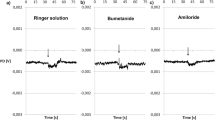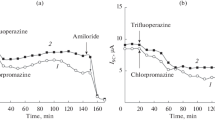Summary
The intracellular concentration of Li ([Li]c) of epithelia isolated from frog skins was determined after a one hour exposure to external Na free Choline Ringer containing from 1 to 25 mM of LiCl. In both open and short circuit conditions, [Li]c was found to have values up to ten times that of the outside Li concentration, indicating accumulation of Li in the epithelia. A loss of an approximately equivalent amount of cellular K was associated with this Li accumulation, whereas no significant change in epithelial content of Na was observed. This accumulation of Li is reduced if Na is present together with Li in the outer solution. Preincubation of the epithelia with Amiloride (10−4 M) suppressed short circuit current and potential difference changes consecutive to externali solutions exposure, prevented Li accumulation and K loss and reduced transepithelial movements of Li. The entry of Li into the cell was speeded up by oxytocin (20 mU/ml). In cyanide (10−4 M) pretreated epithelia, Li uptake was reduced and accumulation failed to occur. 2,4 dinitrophenol (5×10−4 M) also lowered the Li uptake. It is concluded that the main mechanism for monovalent cations entry into the epithelium is a process for which Na and Li compete. The existence of an active transport step at the level of the outward facing membrane of the frog skin epithelium is proposed.
Similar content being viewed by others
References
Aceves, J., Erlij, D.: Sodium transport across the isolated epithelium of the frog skin. J. Physiol. (Lond.)212, 195–210 (1971).
Bentley, P. J., Amiloride: A potent inhibitor of sodium transport across the toad bladder. J. Physiol. (Lond.)195, 317–330 (1968).
Biber, T. U. L.: Inhibition of uptake of sodium at the outer surface of the frog skin by ouabain and amiloride. Fed. Proc.29, 724 (1970).
Biber, T. U. L.: Effect of changes in transepithelial transport on the uptake of sodium across the outer surface of the frog skin. J. gen. Physiol.58, 131–144 (1971).
Biber, T. U. L., Chez, R. A., Curran, P. F.: Na transport across frog skin at low extrenal Na concentrations. J. gen. Physiol.49, 1161–1176 (1966).
Biber, T. U. L., Curran, P. F.: Direct measurement of uptake of sodium at the outer surface of the frog skin. J. gen. Physiol.56, 83–99 (1970).
Cereijido, M., Rotunno, C. A.: The effect of antidiuretic hormone on Na movement across frog skin. J. Physiol. (Lond.)213, 119–133 (1971).
Cereijido, M., Curran, P. F.: Intracellular electrical potentials in frog skin. J. gen. Physiol.48, 543–557 (1965).
Curran, P. F., Herrera, F. C., Flanigan, W. J.: The effect of Ca and antidiuretic hormone on Na transport across frog skin. J. gen. Physiol.46, 1011–1027 (1963).
Dorge, A., Nagel, W.: Effect of amiloride on sodium transport in the frog skin. II. Sodium transport pool and unidirectional fluxes. Pflügers Arch.321, 91–101 (1970).
Ehrlich, E. N., Crabbé, J.: The mechanism of action of Amipramizide. Pflügers Arch.302, 79–96 (1968).
Emilio, N. G., machado, M. N., Menano, H. P.: The production of a hydrogen ion gradient across the isolated frog skin. Quantitative aspects and the effect of acetazolamide. Biochim. biophys. Acta (Amst.)203, 394–409 (1970).
Erlij, D., Aceves, J.: Sodium transport across the isolated epithelium of the frog skin. Biophys. J.9, A 163 (1969).
Erlij, D., Smith, M. W.: Sodium uptake by the outside surface of frog skin. J. Physiol. (Lond.)218, 33–34 (1971).
Furhman, F. A., Ussing, H. H.: A. characteristic response of the isolated frog skin potential to neurohypophyseal principles and its relation to the transport of sodium and water. J. cell. comp. Physiol.38, 109–130 (1951).
Garcia-Romeu, F., Salibian, A., Pezzani-Hernandez, S.: The nature of the in vivo sodium and chloride uptake mechanisms through the epithelium of the chilean frog calyptocephalla gayi. J. gen. Physiol.53, 816–835 (1969).
Hansen, H. H., Zerahn, K.: Concentrations of lithium, sodium and potassium in epithelial cells of the isolated frog skin during active transport of lithium. Acta physiol. scand.60, 189–196 (1964).
Herrera, F. C., Egea, R., Herrera, A. N.: Movement of lithium across toad urinary bladder. Amer. J. Physiol.220, 1501–1508 (1971).
Koefoed-Johnsen, V., Ussing, H. H.: The nature of the frog skin potential. Acta physiol. scand.42, 298–308 (1958).
Krogh, A.: Osmotic regulation in the frog (R. esculenta) by active transport of chloride ions. Skand. Arch. Physiol.76, 60–74 (1937).
Leblanc, G., Lemonnier, R.: Lithium uptake by isolated epithelium from frog skin and its inhibition by Amiloride. Proc. Int. Union of Physiological Sciences, Munich 1971.
Morel, F., Bastide, F.: Action de l'ocytocine sur la composante active du transport de sodium par la peau de grenouille. Biochim. biophys. Acta (Amst.)94, 609–611 (1965).
Morel, F., Maetz, J., Lucarain, C.: Action des deux peptides neurohypophysaires sur le transport actif de sodium et le flux net d'eau a travers la peau de diverses especes de batraiens anoures. Biochim. biophys. Acta (Amst.)28, 619 (1958).
Nargel, W., Dorge, A.: Effect of amiloride on sodium transport of frog skin. Pflügers Arch.317, 84–92 (1970).
Rawlins, F., Mateu, L., Fragachan, F., Whittembury, G.: Isolated toad skin epithelium: transport characteristics. Pflügers Arch.316, 64–80 (1970).
Salako, L. A., Smith, A. J.: Effects of amiloride on active transport by the isolated frog skin: evidence concerning site of action. Brit. J. Pharmacol.38, 702–718 (1971a).
Salako, L. A., Smith, A. J.: Changes in sodium pool and kinetics of sodium transport in frog skin produced by Amiloride. Brit. J. Pharmacol.39, 99–109 (1971b).
Takenaka, S.: Studies on the quasiperiodic oscillation of the electrical potential of frog skin. Jap. J. Med.4, 283–287 (1937).
Teorell, T.: Rhythmical potential and impedance variations in isolated frog skin induced by lithium ions. Acta physiol. scand.31, 268–382 (1954).
Ussing, H. H., Windhager, E. E.: Nature of shunt path and active sodium transport path through frog skin epithelium. Acta physiol. scand.61, 484–504 (1964).
Ussing, H. H., Zerahn, K.: Active transport of sodium as the source of electric current in the short-circuited isolated frog skin. Acta physiol. scand.23, 110–127 (1951).
Walser, M.: Role of edge damage in sodium permeability of toad bladder and a means to avoid it. Amer. J. Physiol.219, 252–255 (1970).
Zerahn, K.: Studies on the active transport of lithium in the isolated frog skin. Acta physiol. scand.33, 347–358 (1955).
Zerahn, K.: Nature and localization of the sodium pool during active transport in the isolated frog skin. Acta physiol. scand.77, 272–281 (1969).
Author information
Authors and Affiliations
Rights and permissions
About this article
Cite this article
Leblanc, G. The mechanism of lithium accumulation in the isolated frog skin epithelium. Pflügers Arch. 337, 1–18 (1972). https://doi.org/10.1007/BF00587867
Received:
Issue Date:
DOI: https://doi.org/10.1007/BF00587867




